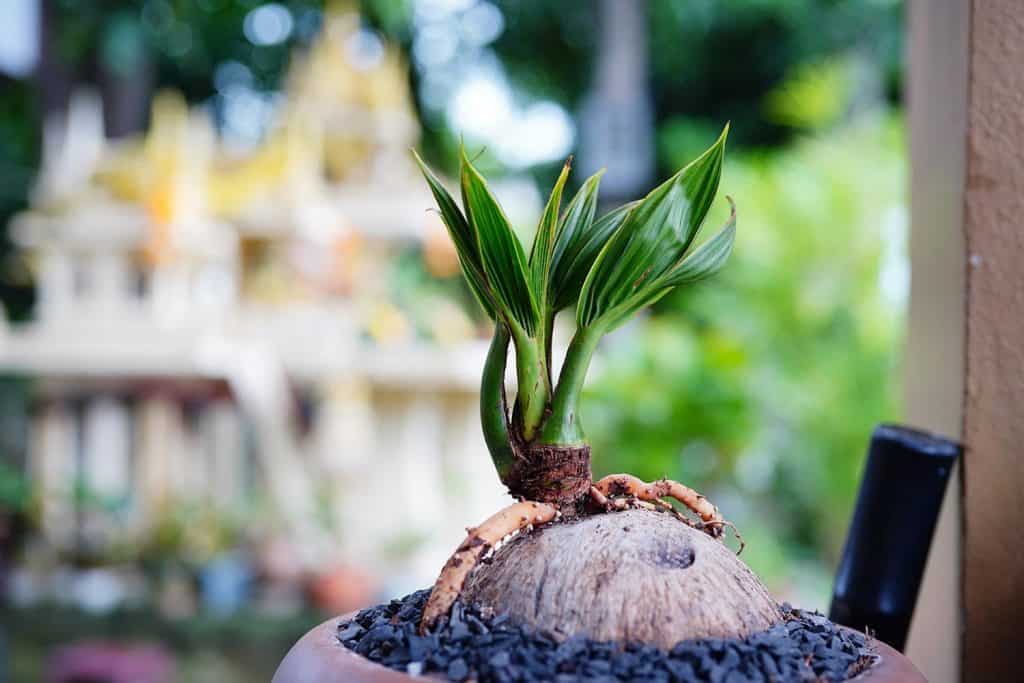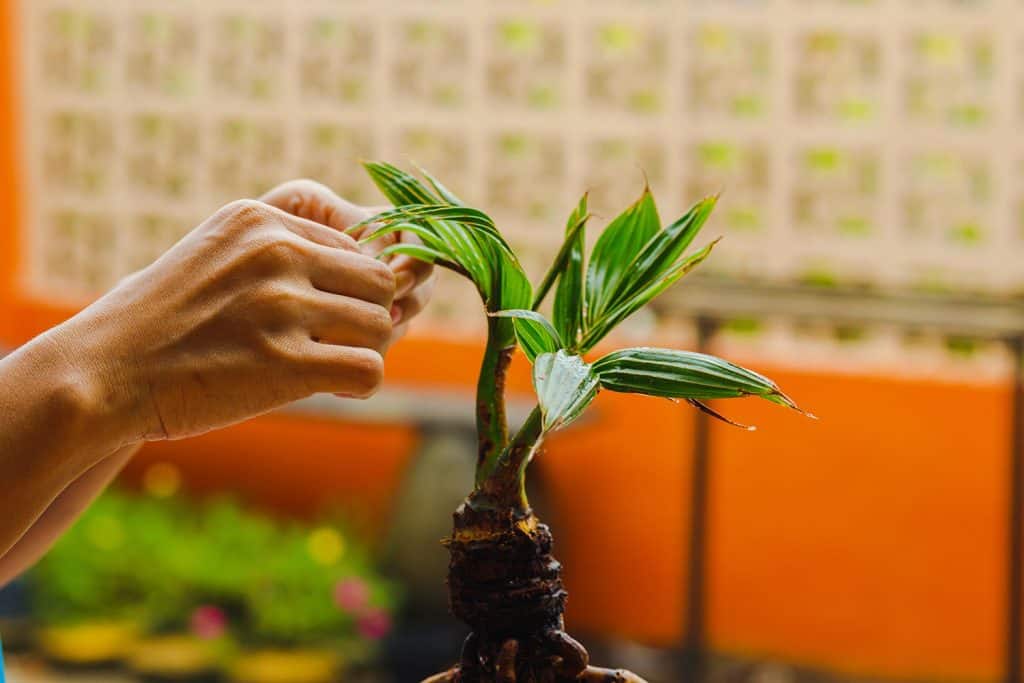Many different trees can be turned into a bonsai-version. Do you want to bonsai a coconut tree but don't know where or when to start? Well, we've done our research and have some answers for you. Let's discuss.
To bonsai a coconut tree, it's best to start your plant from seed. To do this, follow these steps:
- Choose a coconut from a mature, healthy tree.
- Place your coconut into a plastic container or bag.
- Fill your container with sand and dirt, keeping your coconut's stem facing up.
- After your coconut's shoot grows to 25 centimeters, remove it from its container.
- Gently peel off the outer layers of the coconut shell.
- Smooth off your coconut using sandpaper or a sharp knife.
- Wash your coconut in water to remove leftover dirt/debris
- Plant your coconut in a new pot, using nutrient-rich, fast-draining soil.
- Water your new bonsai thoroughly, and you're ready to go!
As we begin, we will cover all things coconut bonsai. Whether you haven't tried bonsai before or want to expand your garden, we're here to help. With that said, let's dive right into this topic!

How Do You Bonsai A Coconut Tree?
If you want to bonsai a coconut tree, you have to start it from seed. Unlike other tree species, you can't train an already established coconut tree to stay small, which makes this process tedious.
Like we covered above, it's essential to choose an intact coconut from a healthy, established mother tree, so you know your bonsai will be able to grow. It's also important to make sure you don't damage your coconut stem or shoot during its beginning stages because this can kill the plant.

Coconut Bonsai Tutorial
Here is a helpful tutorial on how to bonsai a coconut tree from Edy Marwan's official YouTube channel. This video covers the basics of growing a coconut bonsai and gives tips on keeping your tree healthy and strong.
How Long Will Coconut Bonsai Live?
You can expect a coconut bonsai to live for 60 to 80 years, depending on how well you care for it. Coconut trees tend to last quite long as bonsai and can even outlive their outdoor counterparts.
That said, if your bonsai doesn't get adequate sunlight and nutrients, it might not make it past a few years. On top of that, coconut trees take a long time to mature, especially for bonsai.
What Type Of Soil Does Coconut Bonsai Need?
You want to plant your coconut bonsai in sandy, well-draining soil to keep it healthy. Generally, a bonsai-formulated potting mix will work best for coconut trees and promote as much new growth as possible.
It's also important to find soil with a balanced or neutral pH, which is essential to support a bonsai. Bonsai trees thrive in soil with akadama, pumice, lava rock, compost, and fine gravel, so keep an eye out for those options.
Generic - Premium Organic All-Purpose Bonsai Soil
This organic bonsai soil is fast-draining, has premium ingredients, comes in a reusable bag, and works well for small to medium-sized trees.
View this soil on Amazon here.
BonsaiOutlet All-Purpose Organic Mixed Bonsai Tree Blend
This bonsai soil blend is organic, has fine gravel to help improve drainage, 100% double-sifted compost, and comes in a few bag sizes.
Follow this link to see it on Amazon here.
Should I Fertilize My Coconut Bonsai?
It is a good idea to fertilize coconut bonsai regularly. This type of tree, in particular, does well with seasonal fertilizing, especially during its spring and summer growing season.
We recommend going with a slow to continuous-release fertilizer, although a liquid formula will work too. As long as your fertilizer isn't too highly concentrated, it should be fine to use on your bonsai.
Bonsai Fertilizer Pellets by Perfect Plants
This bonsai fertilizer has a slow-release formula, lasts five years, is all-natural, and comes in a five-ounce bag.
See this fertilizer on Amazon here.
How Often Do You Water A Coconut Bonsai Tree?

Ideally, you want to water a coconut bonsai every few days or twice per week. Coconut trees prefer slightly moist soil, but not to the point they are sitting in water.
Especially for indoor bonsai, you want to make sure you don't overwater your tree because this can end up causing more harm than good.
How Much Sun Does A Coconut Bonsai Need?
Coconut bonsai should get between six and eight hours of bright, direct sunlight per day. According to Bonsai Empire, it's best to have your coconut tree be in the sun for at least half of the day or partially shaded if it's hotter than 85 degrees.
Bonsai tends to do better when it gets plenty of direct sunlight and will grow faster than trees in the shade, so keep that in mind when choosing your coconut bonsai's location.
Is Coconut Bonsai An Indoor Plant?
Like many bonsai, coconut trees are also considered indoor-friendly. Technically, no tree will be an indoor plant, but bonsai tend to prefer the moderate and stable climate that a home creates.
Especially if you live somewhere with colder fall and winter seasons, having your bonsai inside is an easy way to keep it alive and growing year-round. That said, it is crucial to place your indoor bonsai near a warm, bright window, or you risk it not growing and blooming correctly.
Are Coconut Bonsai Easy To Care For?
In general, yes, a coconut bonsai will be pretty easy to care for. As long as you give your plant enough water, a sunny location, and fertilize it regularly, you shouldn't run into any problems, making this type of tree a good choice for bonsai.
Most often, coconut trees grow the best in tropical, humid climates, so even giving your bonsai a light misting every few days will help mimic an island-like location. It's also worth noting that coconut trees don't require as much pruning as other species, so you don't have to worry about constant trimming or shaping.
How Do You Make Coconut Bonsai Leaves Small?

To keep a coconut bonsai's leaves small, you have to give it plenty of light. According to Bonsai Tree Gardner, bonsai leaves will stay small, growing in clusters, the more light they get, to preserve energy.
The same goes for a coconut tree, so your bonsai shouldn't be in low light because this can cause its leaves to get bigger. Another way to keep coconut tree leaves small is to prune them with a sharp pair of shears, although doing this too often isn't good for a bonsai.
MOFOPAKOO Bonsai Tree Tool Kit
This bonsai tool kit includes pruning scissors, twig shears, wire cutters, a root pick, tweezers, shaping wires, and it comes with a 100% satisfaction guarantee.
Follow this link to view it on Amazon.
How Often Should You Repot Coconut Bonsai?
Considering that coconut trees are pretty slow growers, you shouldn't need to repot your bonsai more than every three to four years. Generally, coconut bonsai won't outgrow their container but can become top-heavy if they don't have a deep enough pot.
That said, if you start to notice your bonsai's roots circling or coming out of the bottom of its planter, that is an easy indicator it's time to repot your tree.
How Much Does A Coconut Bonsai Cost?
You can usually expect to pay around $100 for a younger coconut bonsai. This price includes its pot and tool kit, although you can always find a healthy tree and get your coconut that way.
Coconut bonsai can be hard to find, so buying a baby coconut tree and training it yourself is more common. That said, it's essential to find a very young coconut tree under a foot tall, so you're able to keep it miniature.
Live Coconut Palm Dwarf
This live coconut palm tree will come grown to 20 inches, is recommended for USDA zone 10, and ships out within two weeks.
Click this link to view it on Amazon.
To Wrap It Up
Whether you have a coconut bonsai currently growing or want to get one, it's essential to know how to take care of it. We found that coconut bonsai can only be grown from seed, which makes this process a bit tedious.
When it comes to maintaining coconut bonsai, make sure to keep your plant well watered, but not to the point its roots become waterlogged. You also want to give your coconut tree plenty of sunlight to keep it growing year-round. Regardless of where you live, make sure to fertilize your coconut bonsai seasonally, and don't be afraid to trim its leaves if they get too big.
Want to know more about bonsai trees? Check out these helpful related plant posts below!
How Big Is A Bonsai Tree? [By Type Of Tree]
My Bonsai Tree Is Dry And Brittle - What To Do?
What's The Best Pot For Bonsai Trees? [Inc. 11 Perfect Examples]





